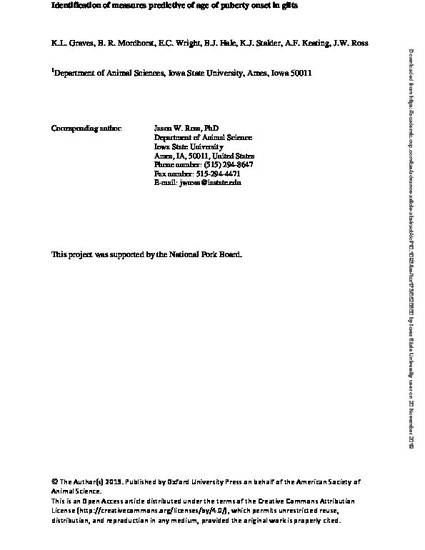
A potential indicator of female lifetime productivity in swine is age of puberty, when a gilt achieves her first behavioral estrus. Follicular activity, as determined by tertiary follicle development, in prepubertal gilts begins during postnatal day (PND) 75-115. The central hypothesis of this study is that gilts demonstrating tertiary follicle development earlier in life, assessed using vulva size as a proxy, achieve puberty earlier in life compared to counterparts of a similar age and weight that lack tertiary follicle development. The objectives of this project were to identify a developmental time point when variation in ovarian development exists and to determine if a relationship between the age prepubertal ovarian development and the age at onset of puberty exists. To accomplish this, 155 gilts of similar age (± 2 days) were weighed and vulva size measured on PND 75, 85, 95, 105 and 115. Vulva measures, including vulva width (VW), length (VL) and area (VA) were utilized as developmental proxies for follicular activity. At each time point, gilts (n = 10) were sacrificed and ovarian follicular activity recorded. In a subset of gilts (n = 105), estrus detection was conducted daily on PND days 126 to 200. Mean vulva area (VA) on PND 75, 85, 95, 105 and 115 was 596 ± 206, 683 ± 190, 864 ± 212, 1014 ± 228 and 1265 ± 252 mm2, respectively. Of the gilts demonstrating behavioral estrus, 28 were within PND 140-160, 36 between PND 161-180, 15 between PND 181-200, and 26 did not demonstrate estrus behavior within 200 days of age. All gilts euthanized at PND 75 lacked follicular activity as defined by having a minimum of two antral follicles per ovary, while 60%, 80%, 90% and 100% demonstrated follicular activity on PND 85, 95, 105, and 115, respectively. Body weight at PND 75 and VW at PND 115 were correlated to age at first estrus (P < 0.05). Of the gilts whose VA was less than one standard deviation from the mean on PND 95 (i.e. < 652 mm2), 31% and 50% demonstrated their first behavioral estrus by PND 180 and 200, respectively. However, of gilts whose VA was within or greater than one standard deviation of the mean (i.e. ≥ 652 mm2), 66% and 79% exhibited estrus prior to PND 180 and 200, respectively. These data support utilization of VA changes between 95 and 115 days of age as a useful tool to identify replacement gilts prior to puberty for inclusion into the sow herd.
Available at: http://works.bepress.com/aileen-keating/41/

This is a manuscript of an article published as Graves, K. L., B. R. Mordhorst, E. C. Wright, B. J. Hale, K. J. Stalder, A. F. Keating, and J. W. Ross. "Identification of measures predictive of age of puberty onset in gilts." Translational Animal Science (2019). doi: 10.1093/tas/txz173.